+
Get in touch 👋🏽
We would love to hear from you.
Contact us to see how we can help.
We would love to hear from you.
Contact us to see how we can help.
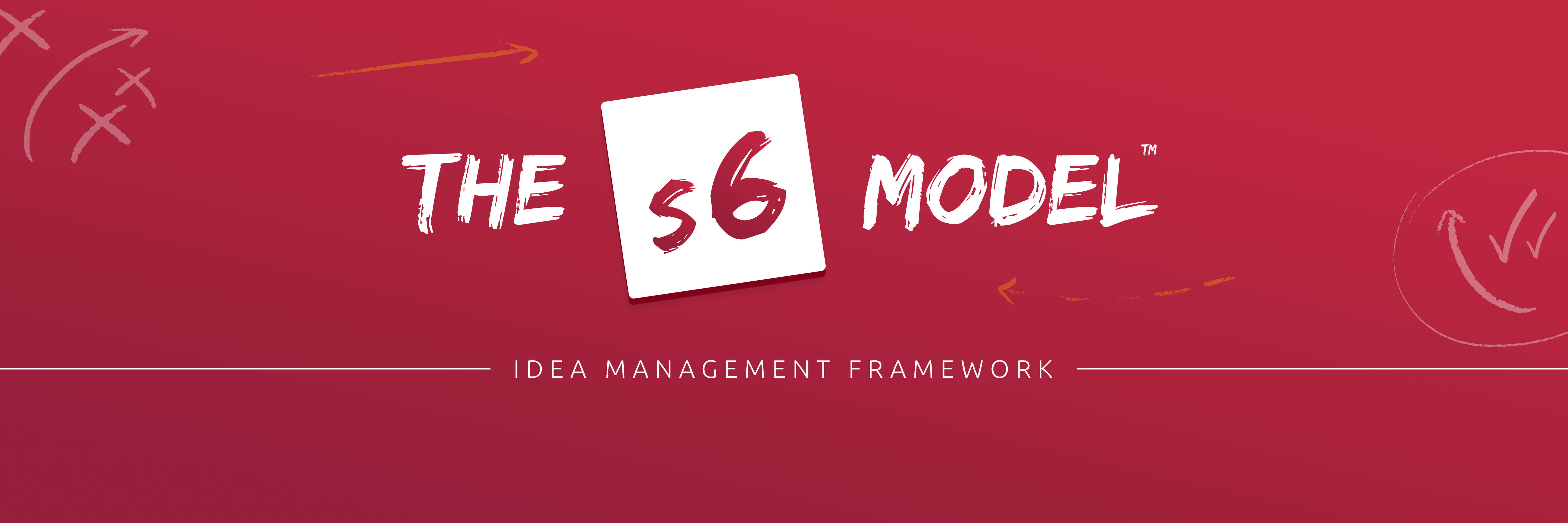
Over the last 7 years, Sideways 6 has had the privilege of helping some of the biggest and best companies in the world to harness the power of employee ideas.
The s6 Model™ is a best practice framework of everything we've learned.
We’ve crunched the data from over half a million ideas and our experience working with organizations in every vertical imaginable, from Nestlé to British Airways, AstraZeneca to Diageo to put all of our best practice advice in one place.
The s6 Model™ will take you through the journey of running an ideas campaign. From deciding on the types of ideas you want to get and how to ask for them, through to bringing the best ones to life and realizing their value.
Read it from end to end or skip to the parts you need help with. Whichever way you use the guide, it’ll provide you with a framework for bringing great employee ideas to life. Good luck!
Click the links to skip to the section you want to cover first:
• Introduction - Employee ideas and the s6 Model™ »
• Planning - Lay the groundwork for success »
• Capture - How to source great ideas from employees »
• Manage - How to categorize and develop ideas »
• Shortlist - How to review and identify the best ideas »
• Implement - How to bring the best ideas to life »
• Engage - How to drive engagement and share updates »
• Analyze - How to measure your success »
If you’re reading this guide, you’re probably already in on the secret. There are endless benefits for companies that listen to their employees, including:
Did you know?
Companies that listen to employees are 21% more profitable than their competition. (Source: Gallup)
4 in 5 employees have ideas to make their companies better, so it’s safe to assume there are a few budding intrapreneurs within your business.
However, despite organizations spending millions on employee engagement and innovation each year, 68% of employees feel their company lacks a structured process for capturing and managing ideas. Creativity is being stifled and valuable ideas lost.
The solution: running effective employee ideas campaigns.
Definition
Employee Ideas Campaign [noun]
An employee ideas campaign is a structured way to encourage employees to contribute constructive ideas for improving the organization in which they work. A campaign typically involves capturing, managing, shortlisting, and implementing ideas in order to create results that have a positive impact on the business.
Broadly speaking, employee ideas campaigns fall into one of three categories depending on the overall objective and the type of ideas you are looking for:
1. Innovation campaigns ask for ideas on fundamentally new products, systems, or processes that are different from the company's existing offering or product portfolio.
Nestlé’s InGenius is a great example »
2. Improvement campaigns seek ideas with the potential to improve the business in the short term and long term. These ideas could range from incremental improvements to transformational changes and are typically centered around optimizing existing products, systems, and processes.
Balfour Beatty’s My Contribution is a great example »
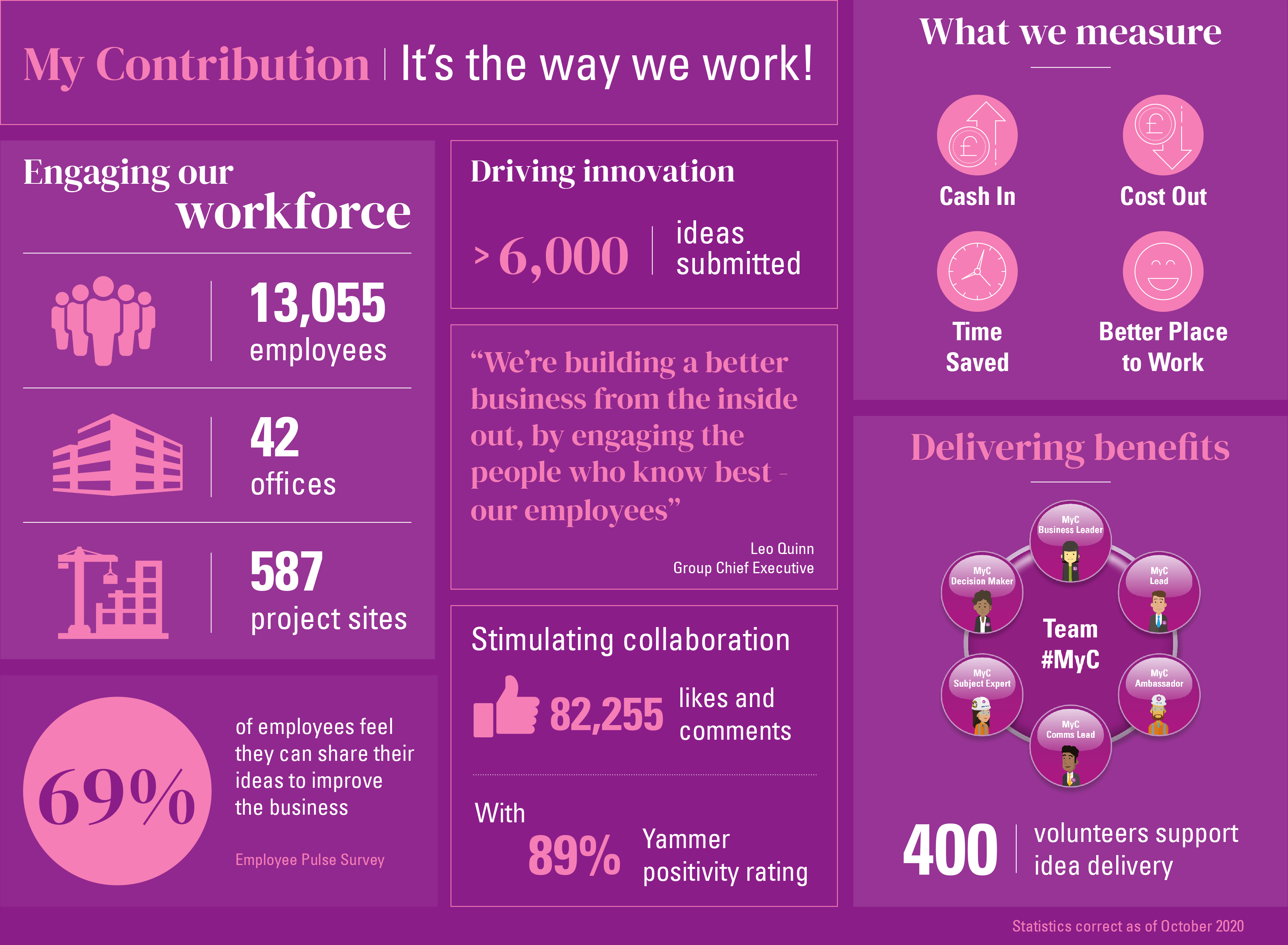
3. Insight campaigns strive to learn from the community, usually through a burst of engagement, whilst at the same time exciting and uniting employees around core topics or themes. Successful ideas submitted are used to inform, inspire or alter company policy and strategy.
AstraZeneca’s AZ2025 is a great example »
You may be thinking, “but my campaign has elements of Improvement and Insight”. You may also be thinking these different campaign types are like apples and oranges, how can there possibly be a one-size-fits-all approach to idea management?
Don’t worry, we’ve got you covered. Throughout the s6 Model™, we'll highlight the nuances of Innovation, Improvement, and Insight campaigns and the ways our best practice advice may differ accordingly.
And for those special hybrid campaigns with elements of Innovation, Improvement, and Insight, feel free to cherry-pick the bits that best suit you and your company!
We’ve built our s6 Model™ around a tried and tested framework for running successful employee ideas campaigns. 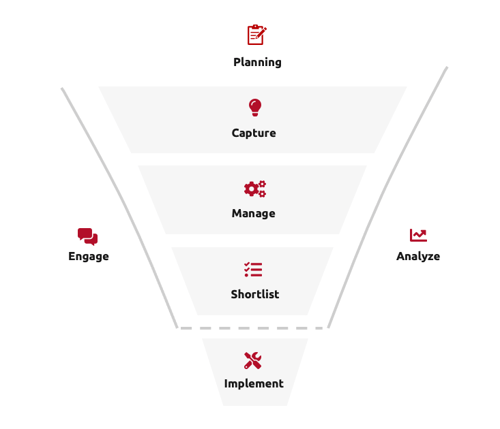
The s6 Model™ framework consists of seven pillars that touch on every part of the campaign planning and idea management process:
Let’s explore each pillar in more detail.
What kind of campaign should I run? How long should it run for? Who should be involved? What makes a good campaign question?
These are probably just a few of the thoughts whizzing around your head as you try to navigate the early stages of campaign planning. Now is the time to get your ducks in a row and lay the foundations for a successful campaign, but the whole process can feel rather daunting.
It’s not always helpful to start with a blank canvas when planning a new project, so we've developed a handy START? framework to help you tick off all the essentials during this initial planning stage and give you the confidence to, you’ve guessed it, start capturing ideas.

Running a successful employee ideas campaign is never a one-person affair. It needs to be a team effort, with stakeholders from across the organization playing distinctive roles to keep the wheels turning.
Every company will have its own unique stakeholders, but the following personas should be involved in campaigns across the board:

Did you know?
Employee ideas campaigns with leadership endorsement achieve around 30% more engagement than those without. Source: The State of Employee Ideas
Employee experience, sustainability, cost-saving, product innovation, business improvement…
Choosing a campaign theme can be tricky when everything feels like a top priority. However, some topics on the Leadership team’s agenda may not be as meaningful or familiar to employees, and vice versa.
The trick is to focus your campaign on something employees know and care about, which is also important to the business. We call this sweet spot the Golden Trinity.

Need some inspiration? Our Employee Ideas Campaign Lookbook highlights the ten most common campaign themes and success stories of companies that have brought them to life.
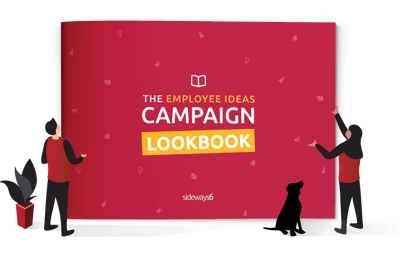 Audience
Audience You’ve lined up your stakeholders and recruited a team of people to stand behind the curtain and keep the campaign moving. The next step is to define your target audience: whose ideas are you interested in hearing?
Great ideas can come from anywhere. In most cases, you should cast the net as wide as possible and keep your audience broad, particularly if the campaign theme is relevant for the whole organization.
However, it often makes sense to focus your campaign on a smaller audience. For example, if your organization operates internationally, you might want to target a specific region or sub-set of employees such as frontline workers.
Once you’ve nailed down your target audience, think about the best way to reach these employees. What tools do they use every day? If the answer is Microsoft Teams, Yammer or Workplace from Facebook then check out our ultimate guides to running campaigns on these channels!
Ask yourself a simple question: “In 12 months' time, what would success look like?” Do you want to find new innovative solutions to business challenges, reduce costs or simply increase employee engagement?
Pro-Tip
When setting objectives, it’s important to start with “why”. What’s your overall objective and reason for running the campaign in the first place?
Objectives can typically be split into two broad categories: engagement and business impact. If you’re running an Insight campaign, engagement is likely to be the top priority whereas implementing ideas and ROI is usually a bigger focus for Improvement campaigns.
Follow the SMART framework when setting objectives - the ‘smarter’ your objectives, the easier it’ll be to assess whether you’ve achieved them.
Did you know?
In a survey conducted on the State of Crowdsourced Innovation, the top listed reasons for running employee ideas campaigns were “building a culture of innovation” (90%) and “increasing employee engagement” (78%). Source: Planview
Are you looking for short-term results or long-term culture change? Trying to solve a specific challenge or build a home for ideas? Your overall objective, which you should now be a little clearer on, will influence the duration of your campaign:
Balfour Beatty’s My Contribution program is a great example »
Pro-Tip
Want the best of both worlds? Run an always-on campaign with targeted sprints on different topics to keep things fresh and engaging.
You’ve ticked off almost every item on your planning checklist but there’s one final bridge to cross. What are you going to ask your employees?
The question you pose to your audience will have a huge impact on the quality and quantity of ideas you receive. You should now have a good steer on the type of ideas you’re looking for, your audience, and the scope of your campaign. These are important influencing factors that will help you decide how broad or narrow your question should be.
Pro-Tip
Keep your target audience firmly in mind and use the kind of language they will understand and connect with, avoiding jargon or technical terms.
The campaign question is the culmination of your theme, objectives, and key results. Here’s an example of what these might look like for an Employee Experience campaign:
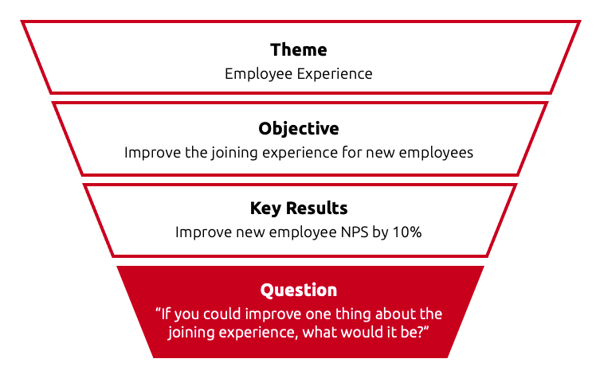
Keep your campaign question short and sweet so it’s crystal clear for your audience - ideally 20 words or less. We’ve developed a campaign question framework based on the art and science of impactful sentence structure. Use it to craft a killer question and make every word count.
Constraints are a necessary condition for creativity to occur.
----- Drew Boyd -----
Before you open the floodgates and start asking for ideas from employees, you need a foolproof method for capturing them all. Can’t have any potential million-dollar ideas slipping through the cracks!
If your campaign fails to capture enough ideas then it’s doomed to fail from the start.
It’s the reason why, here at Sideways 6, we are big believers in the integrated approach which is proven to boost employee engagement and increase the number and quality of ideas captured.
Definition
Integrated Idea Management [noun]
Integrated idea management is an approach of listening to ideas by using pre-existing tools and software, rather than a dedicated ideas application. All the ideas collected are then fed into a single platform where they can be filtered, reviewed and managed accordingly.
Capturing employee ideas via tools like Microsoft Teams, Microsoft Yammer, and Workplace from Facebook removes the friction for employees to share ideas.
.png?width=725&name=MicrosoftTeams-image%20(5).png)
There's no need to log in and learn how to use a dedicated ideas app. Instead, employees simply share and collaborate on the tools they know and love.
Integrated idea management is built upon two fundamental principles:
1) Make it simple to share an idea - it should be quick and easy for employees to share and collaborate on ideas, whenever, wherever they are.
2) Ensure the best ideas can be quickly identified - there should be a smart way for teams to manage, filter, and prioritize the best ideas.
In practice, this means employees are empowered to submit and discuss ideas on the tools they already use in their working day - the 'front-end' of the campaign.
These ideas are then fed into an idea management platform, allowing teams to manage them at scale - the 'back-end' of the campaign.
But what about employees who are not active on your collaboration tools, or simply don’t want to share their ideas publicly? Don’t fret, this is where traditional methods of idea-collection can still work well:
Ideas are the lifeblood of business. Capture every fleeting idea and drive for change.
----- Richard Branson -----
Ideas are flooding into your campaign, now it’s time to separate the wheat from the chaff.
The Manage pillar is where you’ll get your hands dirty, dig out the most promising ideas, and wave goodbye to the ones which sadly won’t be progressing to the next stage in the process.
To manage ideas effectively and at scale, you’re going to need an idea management platform.
There are three key steps to managing ideas at scale:
The following features will take the pain out of idea management and make your life easier:
When qualifying the incoming submissions, the easiest place to start is by identifying the ones that should not move any further:
You should also perform a ‘sense check’ when qualifying the ideas. At first glance, does the idea sound reasonable and feasible? For example, providing all staff with a flashy new company car would certainly improve employee experience, but not many companies would consider this a feasible idea!
You’ve identified the good ideas, now it’s time to ensure they are perfectly packaged up for the expert reviewers.
Merge similar ideas, check all the information submitted is correct, assign owners, tag key themes and reach back out to submitters for any missing information. Enrich as much as you possibly can – your reviewers will thank you!
Pro-Tip
Assign ideas as ‘quick wins’, ‘standard ideas’ or ‘big ideas’ based on the estimated cost and time it would take to bring them to life.
For Innovation campaigns, we recommend categorizing ideas according to the scale of the innovation and time required for development:
Ready, set, review! We’re about to cross the final hurdle before the winning ideas are revealed. The finish line is in sight, but there are a few important things to consider before you race ahead and send your ideas off for review.
When it comes to evaluating employee ideas, we generally favour methods that require the input of multiple reviewers rather than one, potentially biased, opinion. Two excellent methods are:
Pro-Tip
Tap into the knowledge of a wide pool of experts. Breadth of perspective is critical in the early stages of strategic innovation efforts. (Source: The Inovo Group)
Transparency is key. There are many benefits to people knowing the process used for evaluation, including increased engagement, improved communication and a sense of fairness. (Source: Viima).
We’ve put together a list of seven best practice review criteria to help your expert reviewers uncover the most promising employee ideas:
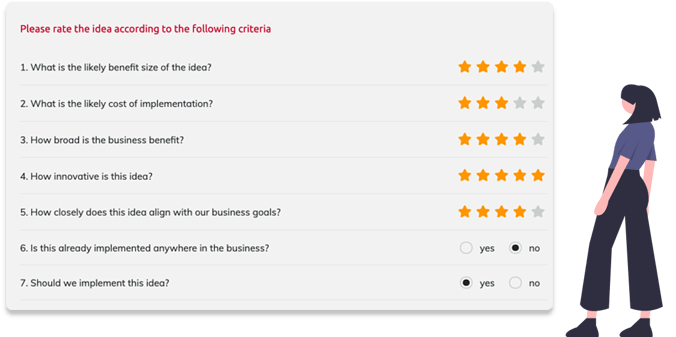
You should also consider the 3 lenses of innovation when selecting your review criteria. Choosing at least two criteria from each lens (desirability, feasibility and viability) will give a robust, well-rounded review of your ideas:
Desirability - Do we want this?
Feasibility - Can we do this?
Viability - should we do this?
Did you know?
According to surveyed participants, ‘Alignment to business strategy’ is the top criteria (62%) used to pick winning ideas. Uniting ideation with a strategic imperative is a powerful method of showing employees how their ideas can influence the company. Source: Planview
It’s important to remember that different kinds of ideas should be evaluated differently, and certain criteria are better aligned to Innovation, Improvement and Insight campaigns. Ultimately, the differences depend on whether ideas are incremental or radical.
Definition
Incremental and Radical Innovation [noun]
Incremental innovation builds on existing capabilities and resources within organizations (continuous improvement) whereas radical innovation implies developing new technical or commercial capabilities. Source: Reid and Bretani.
If your campaign is focused on incremental ideas, review criteria around alignment to current business priorities and cost to implement will be particularly important. For radical ideas, criteria should be modified to manage increased risk and uncertainty and reviewers should adopt a flexible mindset without imposing unnecessary constraints. (Source: Rice et al).
Pro-Tip
The criteria you choose should also be tailored to the skills of your expert reviewers. For example, if an idea would benefit the HR department, it's unlikely that a Finance expert would be able to answer questions requiring specialist HR knowledge.
Implement the best ones! Idea management platforms such as Sideways 6 provide analytics including aggregate review scores to help you decide which ideas to take forward.
You have a few options here. Some of our customers implement all ideas with an aggregated review score of at least 4 stars out of 5, for example, whilst others only implement the top 10 or 20 ideas. If you included the review question “should we implement this idea?”, you could simply take forward the ones marked with a “yes”. Whatever method you choose, try to implement as many ideas as possible!
We’ve also created some handy review data comparison chart templates – plug in your review scores and let the data do the talking.
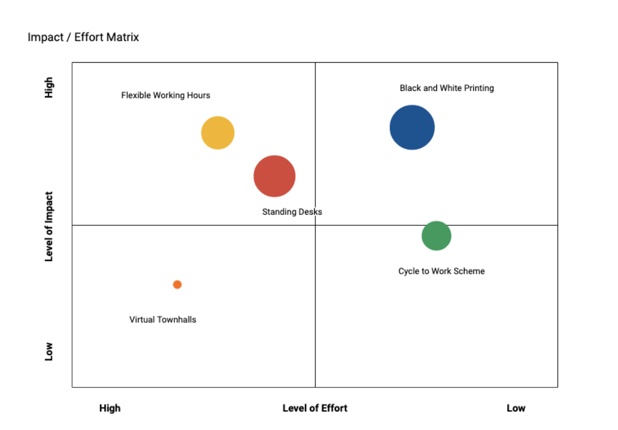
Ideas are easy. Implementation is hard.
----- Guy Kawasaki -----
Bringing ideas to life is a powerful thing. We like to think of it as the ‘flywheel metric’ of employee ideas campaigns; once the wheel is turning, it will lead to lots of other good outcomes and success:
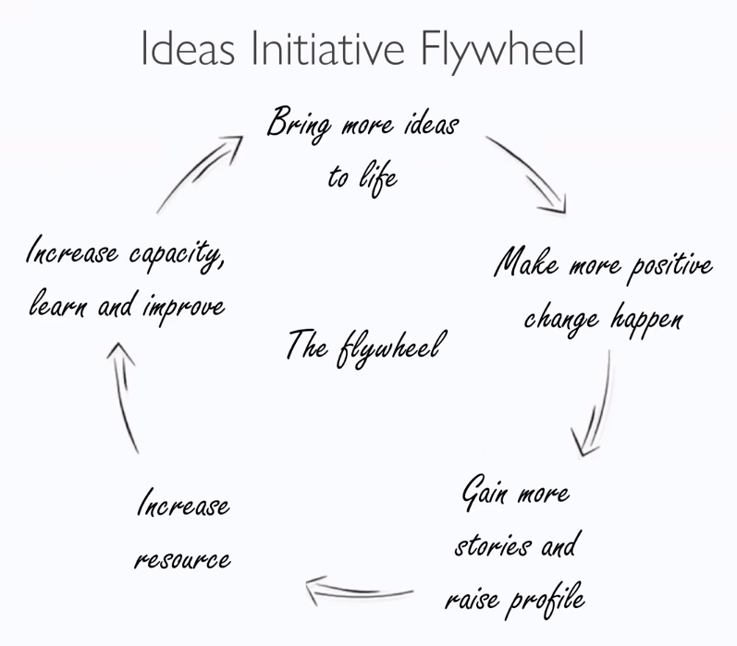
Want to discover the magic for yourself? Follow our top tips for bringing ideas to life:
We covered this in the Planning pillar and it’s so important that we’re mentioning it again! Having a well-resourced sponsor is key to unlocking budget to bring ideas to life.
Pro-Tip
Don’t forget about the middle managers – their support will be invaluable in executing the ideas. Many companies make this a key aspect of people’s roles by including job descriptions and Performance and Development Reviews.
Involve idea submitters in the process of implementation so can they watch their little seed of creativity blossom and come to life. This is particularly important for Innovation campaigns, where radical ideas are often iterated over time before being implemented.
For bigger, more complex ideas, it’s essential to rally up an implementation team with varied skillsets to drive ideas over the finish line. Tap into the knowledge of your expert reviewers, as they will already be familiar with the ideas and invested in their success.
Idea implementation is all about good project management. Schedule regular touchpoints with the relevant project teams to keep track of implementation progress.
Our friends at Asana have some excellent guidance on creating a project plan to keep you and your team on track.
Pro-Tip
The Sideways 6 platform has several features to help you stay on top of implementation management, including an ‘updates’ tab in the Single Ideas Page.
One of the main blockers to implementing ideas is cost, especially when the estimated cost spirals higher than expected. Stop this from happening by asking expert reviewers to provide a more accurate cost of implementation, particularly when you’re confined by limited resources.
Many Improvement campaigns are focused on incremental ideas, which can often be implemented quickly with little cost or effort. Adopt a ‘give it a go’ approach for these ideas and set aside budget for teams to get them off the ground themselves.
Nothing like a bit of healthy competition! Create leaderboards to keep track of implemented ideas across different business units or countries. Share success stories and encourage people to take inspiration from their colleagues.
As you’ve been working your way through each s6 model pillar, you may have noticed one word popping up again and again. Engagement.
Engagement is a thread that should run throughout your entire campaign. Communicating to your audience before the launch, updating submitters on the progress of their ideas, sharing implementation stories… keeping employees engaged is paramount to success.
Every part of your campaign journey is an opportunity for engagement. Here are the key areas to focus on:
First impressions matter. Think of the best adverts you’ve seen on TV: Milky bar kids and Coca Cola Christmas trucks may come to mind. Great adverts are distinctive, memorable and repeatable, seamlessly raising awareness and building trust with the audience.
Your campaign branding should do the same. Get it right and you’ll inspire ideas and spark enthusiasm across the whole company. Follow these top tips for building a brilliant brand:
Check out our Breaking Brand webinar for some inspiring examples from Virgin, General Electric, Nike and more!
Your brand is what other people say about you when you're not in the room.
----- Guy Kawasaki -----
Shout about your campaign on multiple channels to increase your brand presence and reach every corner of the organisation. Here are eight of our favourite promotional methods to help you spread the word and create a buzz:
Did you know?
In the Social Media world, it’s stated that 75% of what makes a campaign successful is what you do to promote it. Source: ShortStack
The only thing worse than not being asked to share an idea is sharing an idea and hearing nothing back about it.
When an idea vanishes into a black hole never to be seen again, it has a destructive effect on engagement. Prevent this from happening by setting up simple automated messages to thank submitters for their idea, update them on any progress and communicate key milestones:
There are plenty of other ways you can maintain momentum and most of the pre-campaign promotion methods we discussed apply here too. Keep things fresh with a bit of gamification – idea leaderboards between regions are an excellent way of injecting some healthy competition into your campaign, just like our friends at Discovery did for their Spark Innovation campaign:
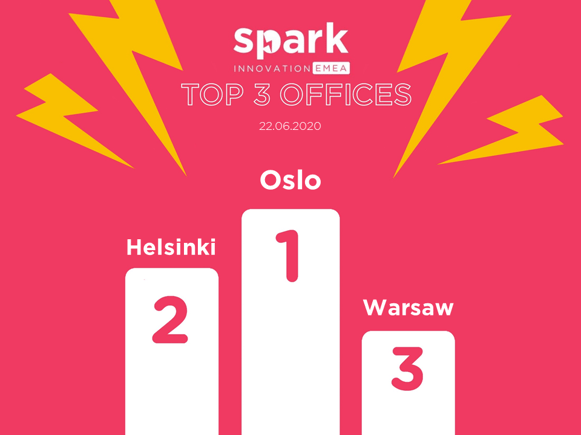
Pro-Tip
Encourage your Executive Sponsors and Campaign Champions to like and comment on ideas throughout the campaign and share regular ideas of their own.
The golden rule of engagement: celebrate success!
Now is the perfect time to share some campaign stats and success stories of ideas being brought to life. Mark these achievements with some good old-fashioned recognition - an ‘awards ceremony’ with Leadership is a great way to round off the campaign in style and a global construction company we are fortunate to have in our customer base does exactly that!
It’s also a good time to demonstrate the business impact of the campaign (plenty more to come on this in the next section!) and make sure the whole company understands the value of listening to employee ideas.
Want to know how idea submitters found the whole experience? Run a post-campaign survey to close the feedback loop and gather some valuable insight for next time.
The campaign has drawn to a close and the results are in. It’s time to look at what you’ve achieved.
Planview’s State of Crowdsourced Innovation survey explores the most commonly tracked metrics for employee ideas campaigns, which fall into three categories: engagement, collaboration and implementation.
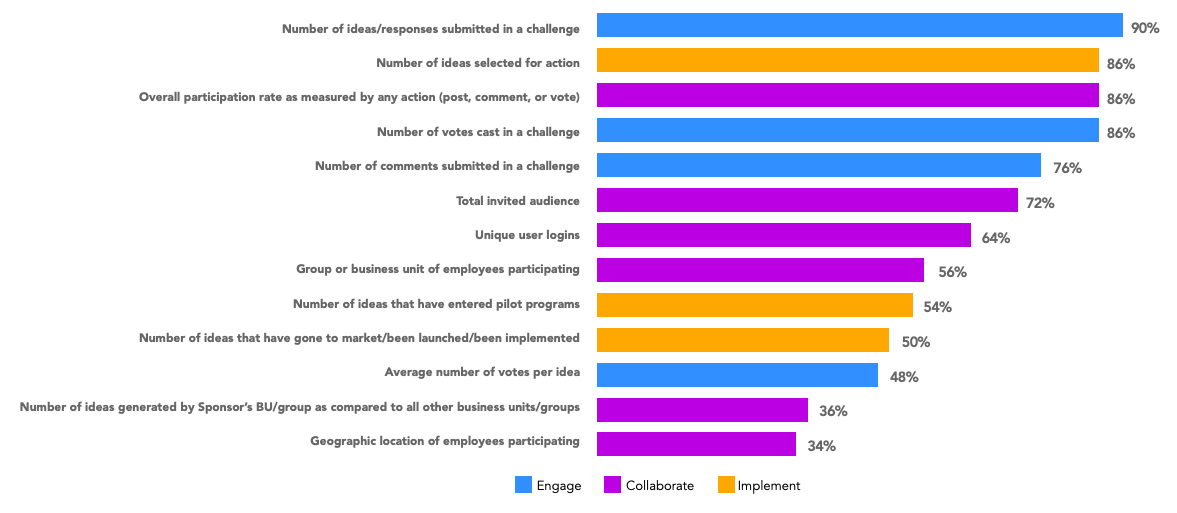
Take a look at your campaign data with these metrics in mind. How do your figures compare to the KPIs you set during campaign planning? For example, did you set a target of 300 ideas and the actual number surpasses this goal? This will be a key indicator of success.
If you’re focusing on engagement, there are likely to be some intangible outcomes that fall outside set metrics. This is particularly true for Insight campaigns, which often reveal important trends about company culture and employee sentiment. Communicate these learnings back to Leadership to paint a broader picture of the success and impact of the campaign.
Pro-Tip
Pull your campaign data into Power BI and augment it with HR data to see which parts of the organisation the ideas have come from
If you look closely at the Planview data, you’ll notice there aren’t as many business impact or implementation metrics on the list. ROI is notoriously difficult to quantify, especially when the idea has just been brought to life. Ask your implementation team to provide an estimated ROI figure, then check back in six months’ time to ensure the projections are still accurate.
Sideways 6 can provide you with an array of insightful campaign-level analytics:
Share these analytics with your Enterprise Social Network, use them to create tailored reports for Leadership, or present them as part of a business review meeting. If you want to give people a real-time, interactive view of your campaign, a Microsoft Power BI dashboard will bring your data to life.
Congratulations! That’s pretty much everything you need to know about running successful employee ideas campaigns.
You’ve been a model student, now it’s time to put it all to practice and create some stunning success stories of your own.
Ideas from Anywhere™
Sideways 6 exists to help bring good ideas to life every day, everywhere from everyone.
»